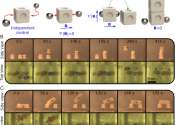All-terrain microrobot flips through a live colon
A rectangular robot as tiny as a few human hairs can travel throughout a colon by doing back flips, Purdue University engineers have demonstrated in live animal models.
Oct 15, 2020
0
75
Robotics

A rectangular robot as tiny as a few human hairs can travel throughout a colon by doing back flips, Purdue University engineers have demonstrated in live animal models.
Oct 15, 2020
0
75
Robotics

visit to the dentist typically involves time-consuming and sometimes unpleasant scraping with mechanical tools to remove plaque from teeth. What if, instead, a dentist could deploy a small army of tiny robots to precisely ...
Apr 25, 2019
1
1643
Robotics

For the first time ever, researchers at the Surgical Robotics Laboratory of the University of Twente successfully made two microrobots work together to pick up, move and assemble passive objects in 3D environments. This achievement ...
Oct 24, 2023
0
94
Robotics

In a new study published in the Proceedings of the National Academy of Sciences, researchers from University of Toronto have demonstrated a novel and non-invasive way to manipulate cells through microrobotics.
Jul 8, 2019
0
431
Robotics

Most synthetic materials, including those in battery electrodes, polymer membranes, and catalysts, degrade over time because they don't have internal repair mechanisms. If you could distribute autonomous microrobots within ...
Dec 10, 2019
0
256
Robotics

Over the past few years, robotics researchers have designed tiny and untethered swimming robots, also known as microswimmers, with increasingly advanced sensing and locomotion capabilities. These microrobots could prove very ...
Robotics

Controlling microscopic processes is inherently challenging. The everyday tools we use to manipulate matter on the macroscale can't simply be shrunk down to the size of cell, and even if they could, the physical forces they ...
Dec 1, 2022
0
77
Robotics

Scientists from the Department of Mechanical Engineering at Osaka University introduced a method for manufacturing complex microrobots driven by chemical energy using in situ integration. By 3D-printing and assembling the ...
Nov 17, 2022
0
45
Robotics

A team of researchers from the Harbin Institute of Technology in China and Michigan State University in the U.S. has developed a way to control swarming microrobots that are able to form into multiple types of shapes. In ...
Robotics

A research collaboration between Cornell and the Max Planck Institute for Intelligent Systems has found an efficient way to expand the collective behavior of swarming microrobots: Mixing different sizes of the micron-scale ...
Jun 5, 2023
0
193
Microbotics (or microrobotics) is the field of miniature robotics, in particular mobile robots with characteristic dimensions less than 1 mm. The term can also be used for robots capable of handling micrometer size components.
Microbotics is that branch of robotics, which deals with the study and application of miniature ones like mobile robots of micrometre scale.
While the 'micro' prefix has been used subjectively to mean small, standardizing on length scales avoids confusion. Thus a nanorobot would have characteristic dimensions at or below 1 micrometer, or manipulate components on the 1 to 1000 nm size range. A microrobot would have characteristic dimensions less than 1 millimeter, a millirobot would have dimensions less than a cm, a minirobot would have dimensions less than 10 cm, and a small robot would have dimensions less than 100 cm.
The earliest research and conceptual design of such small robots was conducted in the early 1970s in (then) classified research for U.S. intelligence agencies. Applications envisioned at that time included prisoner of war rescue assistance and electronic intercept missions. The underlying miniaturization support technologies were not fully developed at that time, so that progress in prototype development was not immediately forthcoming from this early set of calculations and concept design. (ESL Inc., 1970)
The concept of building very small robots, and benefiting from recent advances in Micro Electro Mechanical Systems Due to their small size, microbots are potentially very cheap, and could be used in large numbers (swarm robotics) to explore environments which are too small or too dangerous for people or larger robots. It is expected that microbots will be useful in applications such as looking for survivors in collapsed buildings after an earthquake, or crawling through the digestive tract. What microbots lack in brawn or computational power, they can make up for by using large numbers, as in swarms of microbots.
Microbots were born thanks to the appearance of the microcontroller in the last decade of the 20th century, and the appearance of miniature mechanical systems on silicon (MEMS), although many microbots do not use silicon for mechanical components other than sensors.
One of the major challenges in developing a microrobot is to achieve motion using a very limited power supply. The microrobots can use a small lightweight battery source like a coin cell or can scavenge power from the surrounding environment in the form of vibration or light energy. Microrobots are also now using biological motors as power sources, such as flagellated Serratia marcescens, to draw chemical power from the surrounding fluid to actuate the robotic device. These biorobots can be directly controlled by stimuli such as chemotaxis or galvanotaxis with several control schemes available.
Nowadays, owing chiefly to wireless connections, like Wi-Fi (i.e. in domotic networks) the microbot's communication capacity has risen, so it can coordinate with other microbots to carry out more complex tasks.
As of 2008, the smallest microrobots use a Scratch Drive Actuator.
This text uses material from Wikipedia, licensed under CC BY-SA